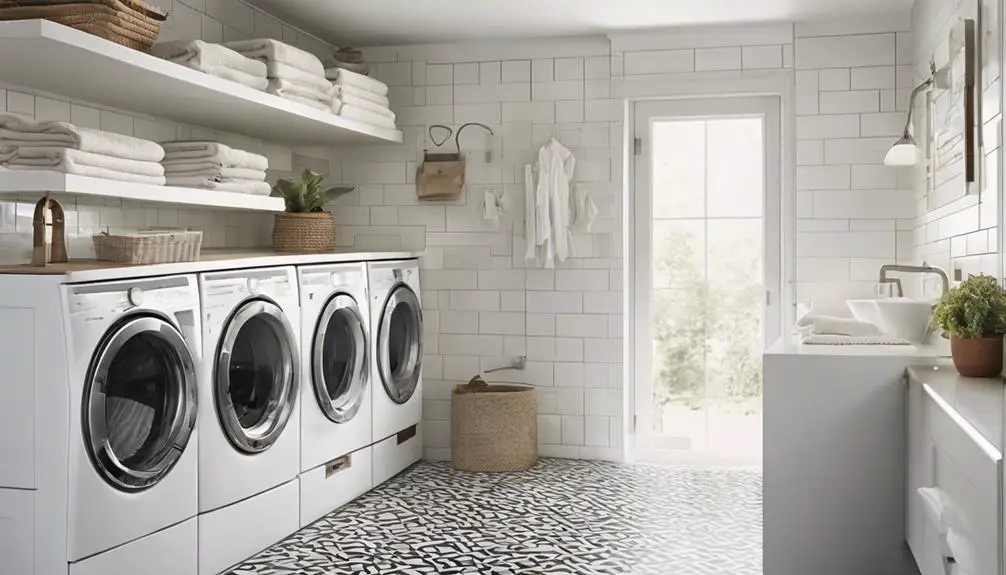As you plan your laundry room layout, you're likely thinking about how to make the most of the space you have. You've probably considered the essentials, like a washer and dryer, but what about the rest? How can you optimize the layout to make doing laundry more efficient and even enjoyable? From clever storage solutions to cleverly designed workstations, there are many ways to create a laundry room that works for you. But where do you start?
Maximizing Space in Small Rooms
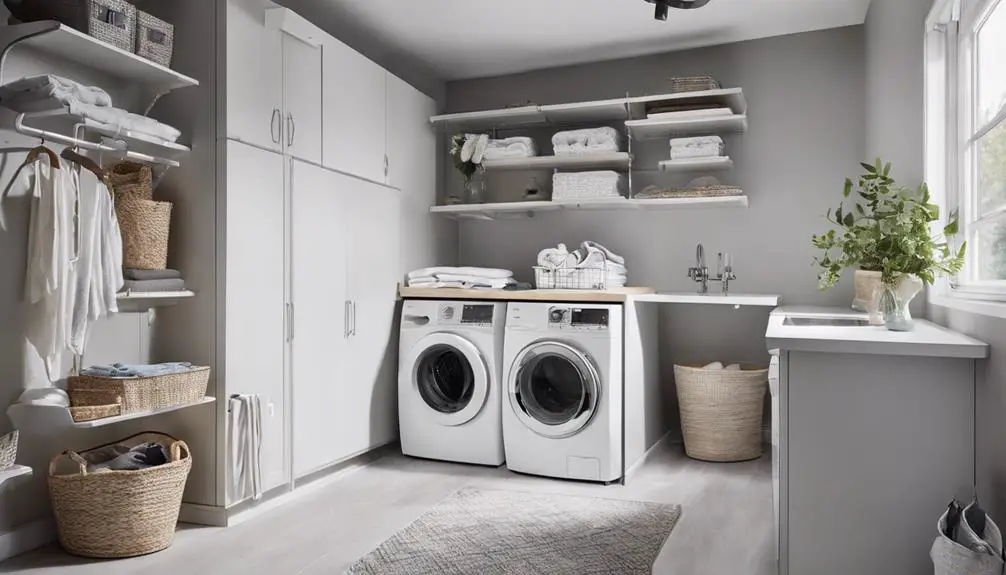
In the confines of a small laundry room, efficiency is key. You need to make the most of the limited space available.
One way to do this is by opting for small appliances that serve the same purpose as their larger counterparts. Compact designs are your friend in this scenario. Consider a compact washer and dryer combo that can be stacked to save floor space.
This will give you more room to move around and possibly even add a small folding table or storage shelves.
When choosing appliances, look for ones with a slim profile or those that can be wall-mounted. This will help keep the floor clear and create the illusion of more space.
Consider a pedestal sink instead of a traditional vanity, and opt for a wall-mounted ironing board to save space. Every inch counts in a small laundry room, so make sure to measure carefully before making any purchases.
Utilizing Corner Areas Efficiently
Because corner areas often get wasted, it's crucial to maximize them efficiently in your laundry room.
By doing so, you'll create a more functional and organized space. One effective way to utilize corner areas is by incorporating corner shelving.
This design element allows you to store laundry supplies, linens, or cleaning products, keeping them within easy reach. You can opt for adjustable shelving to accommodate items of varying sizes.
Another innovative approach is to install curved cabinets in corner areas.
These cabinets provide a seamless, sleek look while maximizing storage. You can customize them to fit your laundry room's unique dimensions, ensuring a perfect fit.
Curved cabinets can house laundry baskets, irons, or other essentials, keeping them hidden from view. By utilizing corner areas efficiently, you'll create a more streamlined laundry room that's both functional and visually appealing.
Creating a Workstation Workflow
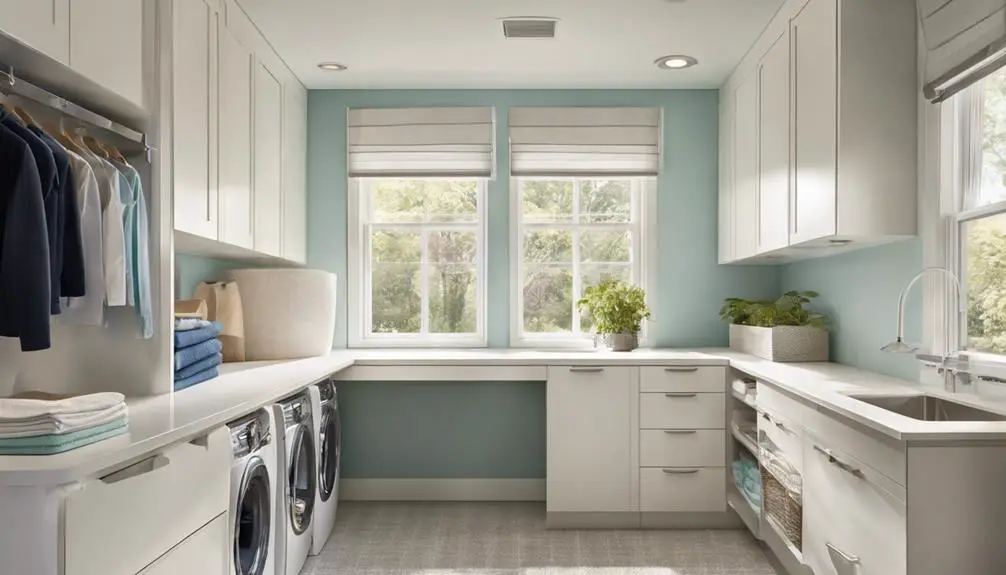
As you step into your laundry room, envision a workflow that flows smoothly from one task to the next.
To achieve this, divide the space into workstation zones, each dedicated to a specific task.
Start by designating a zone for sorting, where a built-in counter or a freestanding island provides ample space to separate lights from darks.
Next, create a washing zone, where the washer and dryer are positioned side by side, allowing for easy transfer of clothes.
Consider installing a folding station above or adjacent to the washer, complete with a countertop, cabinets, or shelves to store folding supplies.
Task flow optimization is key to an efficient workstation workflow.
Position the ironing board near the folding station, and hang a pegboard nearby to store frequently used items like irons, steamers, and laundry bags.
Incorporating Storage Solutions
Your laundry room's overall functionality hinges on incorporating storage solutions that cater to your specific needs.
A well-organized space not only boosts efficiency but also reduces clutter and visual chaos. Consider installing shelves with dividers to separate laundry supplies, such as detergent, fabric softener, and stain removers.
This will keep them within easy reach while preventing them from getting jumbled together.
Storage bins are another essential component of a well-designed laundry room. Choose bins that fit snugly under shelves or in corners to maximize space.
Label each bin to identify its contents, ensuring you can quickly find what you need. For example, designate one bin for delicates, another for cleaning rags, and a third for lost socks.
Shelf dividers can also help maintain order by separating folded laundry, clean linens, or ironing supplies.
Designing for Accessibility Needs

As you plan your laundry room layout, you'll want to create easy navigation paths that allow you to move freely around the space.
This means positioning your washer, dryer, and sink in a way that leaves ample clear floor space between them, ensuring you can comfortably move from one task to the next.
Easy Navigation Paths
In a well-designed laundry room, the path to the washer, dryer, and sink should be obstacle-free, allowing you to move efficiently and safely.
This means creating open traffic lanes that enable you to navigate the space with ease. Aim for a minimum of 3-4 feet of clearance between the washer, dryer, and any surrounding obstacles, ensuring smooth circulation around the room.
To achieve this, consider the "work triangle" concept, where the washer, dryer, and sink form the points of a triangle.
This layout allows you to move quickly and easily between each station, reducing fatigue and increasing productivity. Additionally, position the washer and dryer at a comfortable height to minimize bending and straining.
Clear Floor Space
Amidst the hustle and bustle of laundry day, a clutter-free floor becomes your best friend.
It's vital to design your laundry room with clear floor space to facilitate easy movement and accessibility. You'll appreciate the extra room to maneuver when lugging heavy baskets or circumventing around open doors.
To achieve this, consider installing floor mats that define the workspace while protecting your floors from water and detergent spills.
These mats come in various designs, from simple strips to decorative patterns, and can be easily cleaned and maintained.
Open shelves are another key element in maintaining clear floor space.
By storing laundry supplies, such as detergent and fabric softener, on wall-mounted shelves, you'll keep the floor clear of clutter and tripping hazards.
This thoughtful design decision also makes it easier to reach frequently used items, reducing strain on your back and shoulders.
With a clutter-free floor, you'll be able to focus on getting your laundry done efficiently and safely.
Separating Washing and Drying Areas
Two distinct zones within your laundry room can substantially improve its functionality: one dedicated to washing and another to drying.
By separating these areas, you'll create a more efficient and organized space.
The wet zone, where you'll place your washing machine, should be designed with water resistance in mind.
Consider installing waterproof flooring, walls, and countertops to prevent water damage.
You may also want to add a utility sink or a slop sink to make cleaning up spills and pre-treating stains easier.
In contrast, the dry station is where you'll place your dryer and potentially a drying rack or a clothesline.
This area should be well-ventilated to remove heat and moisture.
You can install a vent or a window to improve airflow and reduce the risk of mold growth.
Adding a Folding Station Table
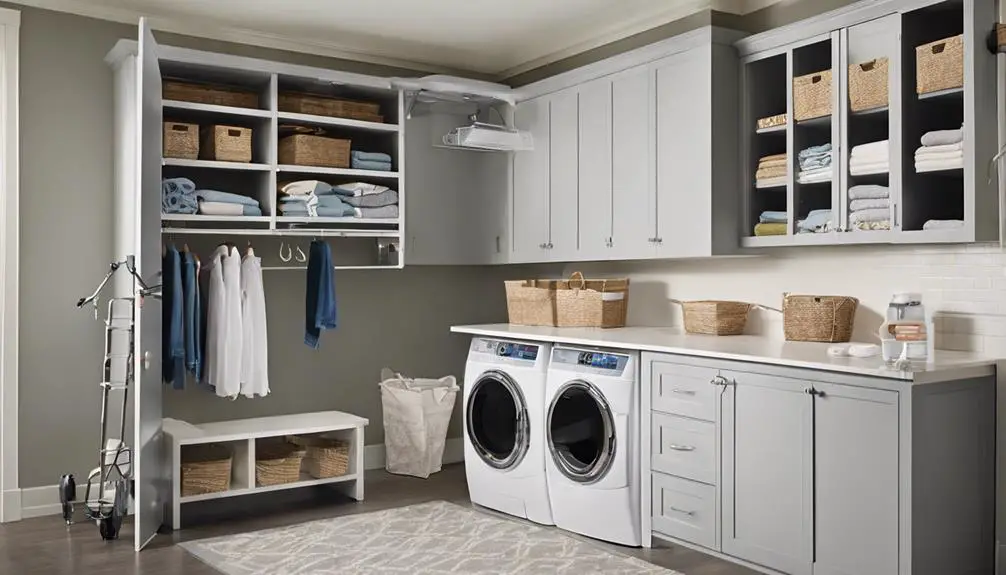
You'll want to ponder space-saving design options for your folding station table, such as a wall-mounted or slide-out model, to maximize floor space in your laundry room.
Ergonomic folding heights will also be vital to prevent straining and discomfort while folding clothes.
Additionally, think about incorporating built-in storage solutions, like cabinets or shelves, to keep folding supplies and linens within easy reach.
Space-Saving Design Options
Efficiency converges with functionality in a laundry room where every inch counts.
To maximize space, consider incorporating compact units that serve multiple purposes. A folding station table with built-in storage, for instance, can hold detergent, fabric softener, and other essentials, keeping them out of the way but still within reach.
In smaller laundry nooks, a wall-mounted folding table can be a game-changer. These space-saving designs allow you to fold and sort clothes without taking up valuable floor space.
Look for tables with adjustable heights to accommodate your needs, and consider adding a built-in ironing board for added convenience.
When designing your laundry room, think vertically. Install shelves or cabinets above your washer and dryer to store items like cleaning supplies, extra towels, and linens.
This will keep your floor clear and make the most of your available space. By incorporating these space-saving design options, you'll be able to create a functional and efficient laundry room that makes doing laundry a breeze.
Ergonomic Folding Heights
A sturdy, compact folding station table anchored to the wall or standing on sturdy legs becomes the command center of your laundry room, streamlining the folding and sorting process.
This ergonomic hub is designed to optimize your workflow, providing a comfortable and efficient space to tackle the never-ending piles of laundry.
When selecting a folding station table, prioritize ergonomic standards to create a folding comfort zone that works for you.
Consider the ideal height that allows you to stand comfortably with your elbows at a 90-degree angle, reducing strain on your back and shoulders.
Typically, this falls between 32 and 36 inches above the floor.
A table with adjustable height settings can accommodate different users and tasks, ensuring a customized fit for ultimate comfort.
Additionally, look for a table with a spacious surface area, allowing you to lay out multiple items at once.
A built-in ironing board or hanging rod can further enhance the functionality of your folding station.
Built-In Storage Solutions
As your folding station table becomes the central hub of your laundry room, incorporating built-in storage solutions will help maintain a clutter-free space and keep your workflow organized.
You'll appreciate the added convenience of custom cabinets installed above or below your folding surface, providing ample storage for laundry supplies, cleaning products, and other essentials. Sliding drawers can be designed to fit snugly beneath your folding station, allowing you to easily access frequently used items like detergent, fabric softener, and stain removers.
To maximize storage capacity, consider installing a combination of fixed and adjustable shelves within your custom cabinets.
This will enable you to store bulky items like laundry baskets and ironing boards, while reserving space for smaller items like lint rollers and sewing kits. By integrating built-in storage solutions, you'll create a laundry room that's not only functional but also visually appealing.
The result is a space that's both efficient and enjoyable to work in.
Installing Shelves and Cabinets
Your laundry room's walls are now ready to be transformed into a storage powerhouse with the installation of shelves and cabinets.
This is where you can get creative with your design, maximizing every inch of space to create a functional and organized area.
Begin by installing shelves with dividers to separate laundry supplies, cleaning products, and other essentials.
These dividers will keep items from getting jumbled and make it easy to access what you need.
Next, consider the type of cabinets that will best suit your needs.
Look for ones with adjustable shelves and soft-close drawers to guarantee a smooth, quiet operation.
Don't forget to choose stylish cabinet hardware that complements your laundry room's aesthetic.
From modern knobs to sleek handles, the right hardware can elevate the overall look of your space.
Incorporating Natural Light Sources

As you design your laundry room, you're probably thinking about how to brighten up the space.
Consider installing skylights or vaulted ceilings to bring in natural light from above, illuminating your entire room.
Strategically placing windows on walls with the best solar orientation will also help maximize the amount of sunlight that pours in.
Skylights and Vaulted Ceilings
Natural light pouring into your laundry room can elevate the entire space, making it feel fresher and more inviting.
By incorporating skylights and vaulted ceilings, you can create a sense of ceiling drama that draws the eye upward, making the room feel more spacious and airy.
Vaulted ceilings, in particular, can add a sense of grandeur to the space, creating a natural ambiance that's both calming and uplifting.
When it comes to skylights, consider installing them above your laundry sink or folding area to create a sense of connection to the outdoors.
This won't only provide natural light but also create a visual break from the monotony of laundry tasks.
Additionally, skylights can be designed to open, allowing fresh air to circulate and further enhancing the sense of natural ambiance.
Window Placement Strategies
Strategically placed windows can become a game-changer in your laundry room, bringing in an abundance of natural light while also framing picturesque views.
When planning your window placement, consider the direction of the sun and how it will affect the daylighting effects in your space. East- or west-facing windows are ideal for capturing gentle, soft light, while south-facing windows will bring in more intense, direct sunlight.
To maximize natural light, position your windows above your laundry machines or on adjacent walls. This will create a sense of brightness and airiness, making the space feel more expansive.
Additionally, consider incorporating window sills that double as shelves or ledges to add storage and display space. This will also create a visual connection between the indoors and outdoors.
Hiding Laundry Room Eyesores
You stand in your laundry room, surrounded by the hum of the washer and dryer, and can't help but notice the unsightly mess of pipes, wires, and utility boxes.
These necessary evils can quickly turn your laundry room into an eyesore. To combat this, consider implementing laundry room camouflages that blend seamlessly into the space. For instance, you can install a decorative screen to conceal the utility boxes, or use a wall-mounted shelf to hide the pipes.
To add an extra layer of disguise, incorporate design elements that draw the eye away from the unsightly areas.
A statement light fixture or a vibrant piece of artwork can distract from the mess, creating a more visually appealing space. Additionally, consider using a laundry room cabinet or shelving unit with a decorative door or panel to hide the washer and dryer.
Creating a Multipurpose Space
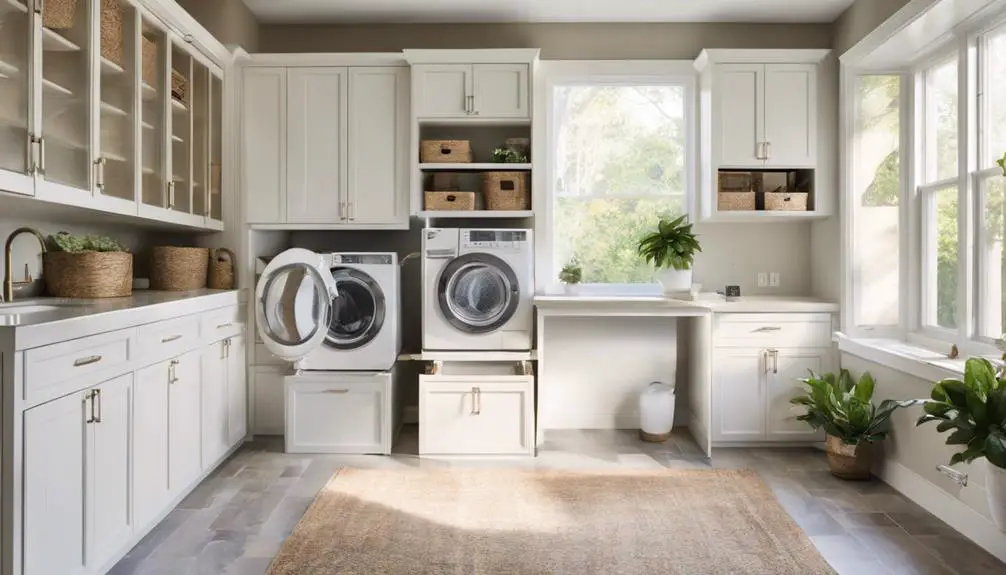
Beyond the domain of laundry duties, your laundry room can serve as a hub for other activities, freeing up valuable space in the rest of your home.
By incorporating multipurpose decor and flexible furniture, you can transform this space into a functional area that accommodates multiple tasks.
Consider adding a built-in desk or a floating shelf to create a workspace for tasks like paying bills, planning meals, or even working remotely.
A comfortable stool or chair can also be tucked away in a corner, providing a cozy nook for reading or relaxing.
In addition, you can utilize wall-mounted shelves or hooks to store items like bags, accessories, or even cleaning supplies.
This will keep the floor clear and create a sense of openness, making the room feel larger than it actually is.
Accommodating Large Capacity Machines
Many modern laundry rooms feature large capacity washing machines and dryers that can handle bulkier or heavier loads, making them a practical choice for busy households.
When accommodating these machines, consider their placement carefully to maximize floor space and optimize workflow. Place them side by side, allowing for a convenient transfer of clothes from washer to dryer.
Alternatively, install them in a stacked configuration to save floor space, but confirm the machines are designed for this setup.
To enhance energy efficiency, look for machines with the ENERGY STAR certification, which indicates they meet energy efficiency standards set by the U.S. Environmental Protection Agency.
Additionally, consider machines with advanced features like moisture-sensing technology, which can reduce energy consumption by detecting the ideal drying time.
When planning your laundry room layout, remember to leave sufficient space around the machines for easy maintenance and repair.
A minimum of 12 inches of clearance on all sides is recommended.
Frequently Asked Questions
Can I Use a Laundry Room for Other Purposes Besides Laundry?
You can repurpose a laundry room into a multi-functional space that serves you well. Why not convert it into a cozy home office or a craft station, where you can tap your creativity and still have a dedicated area for laundry duties?
How Do I Minimize Noise From Washing Machines and Dryers?
You'll effectively minimize noise from washing machines and dryers by incorporating soundproofing materials, like acoustic panels and mass loaded vinyl, and employing noise reduction techniques, such as decoupling and damping, to create a quieter laundry space.
What Are the Benefits of Having a Sink in a Laundry Room?
You'll appreciate having a sink in your laundry room as it becomes a wet station, allowing you to pre-treat stains, wash delicates, and clean messes easily, making your utility sink a hardworking hub for efficient laundry day operations.
Can I Install a Laundry Room on an Upper Floor or Only on the Ground Floor?
You can install a laundry room on an upper floor, but be aware of upper floor challenges like noise, vibration, and plumbing complexities, which may outweigh laundry convenience, making a ground floor location more practical and efficient.
How Often Should I Clean and Maintain My Laundry Room?
You should establish daily schedules to quickly wipe down machines and sweep floors, and set aside time for deep cleaning tasks, like scrubbing walls and reorganizing storage, to keep your laundry room spotless and efficient.
Conclusion
As you finalize your laundry room design, remember to balance functionality with aesthetics. Visualize the flow of your space, ensuring each zone works in harmony. By incorporating clever storage, maximizing corner areas, and prioritizing accessibility, you'll create a haven that's both efficient and inviting. With these laundry room layout ideas, you'll be folding your way to a clutter-free, stress-free space that's a joy to be in.
